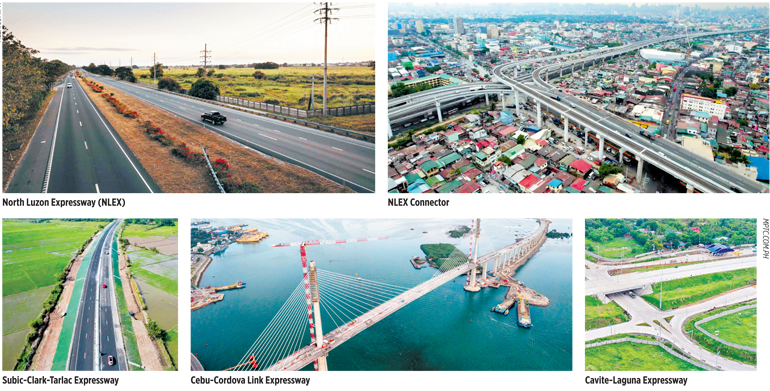Connecting the Philippines through legacy infrastructure

Part of nation-building is ensuring physical structures like roads, power lines, or hospitals are in place to facilitate commerce, connect cities, and improve the quality of life in a region. Infrastructure is essential in creating an environment that enables economic prosperity and development in a country.
As a savvy business mogul who has been a fixture in improving life for Filipinos, Manuel V. Pangilinan, more often referred to as MVP, has made significant contributions across major industries in the Philippines such as telecommunications, utilities, media, and sports. As the chairman and CEO of Metro Pacific Investments Corp. (MPIC), Mr. Pangilinan has been instrumental to laying the foundation for the infrastructure that connects the Philippines today.
Through MPIC’s tollway unit, Metro Pacific Tollways Corp. (MPTC), MVP has provided a safe and convenient mobility experience to travelers as well as brought progress to communities through sustainable infrastructure. In terms of vehicle traffic volume, revenue levels, asset base, and the combined length of expressways, the MPTC is the largest toll road developer in the Philippines.
One of their developments, in a joint venture with the Philippine Reclamation Authority (PRA), is the Manila-Cavite Expressway Project (CAVITEX), a 14-kilometer (km) tollway that traverses the Coast of Manila and connects Roxas Boulevard to Cavite. With exits to Bacoor, Las Piñas, and Kawit, Cavite, the road was designed to link Metro Manila with thriving provinces in Southern Luzon. Inaugurated by then President Benigno S.C. Aquino III in 2011, CAVITEX has eased traffic on major stretches and reduced travel time for Filipinos going to Cavite.
Recently, it was reported that the Pangilinan-led company is keen on buying out the remaining interest of the government. In their current deal, the PRA operates and manages the expressway while MPTC’s subsidiary, Cavitex Infrastructure Corp., is tasked with the design, finance, and construction of the toll roads.
Another connector of provinces in Southern Luzon, the MPTC’s Cavite-Laguna Expressway (CALAX) reduces the travel time from Kawit, Cavite to Biñan, Laguna from two hours to 35 minutes. The 44.58-km four-lane closed-system tolled expressway is a private-public partnership between the Department of Public Works and Highways, as the implementing agency; and MPCALA Holdings, Inc., a subsidiary of the MPTC.
CALAX is uniquely designed to feature several commercial establishments and is equipped with state-of-the-art technology such as an Automatic License Plate Recognition System that allows barrier-less entry, IP-based Speed Detection Cameras, and CCTVs. The expressway recently opened its Silang-Aguinaldo Interchange that leads to Tagaytay City last year and is on track to complete its Governor’s Drive Interchange by third quarter of 2025.
Pioneering expressways in the Visayas region, MVP’s MPTC built the country’s longest and tallest bridge connecting Mactan Island with mainland Cebu through the Cebu-Cordova Link Expressway (CCLEX). The 8.9-km CCLEX is the Pangilinan-led company’s first venture outside of Luzon and the first tollway of the MPTC to be fully cashless.
Recently opened in 2022, the tollway is set to add the Guadalupe ramp which will connect three interior villages in the city to the CCLEX and make a significant impact to the local economy. The construction of the P6-billion ramp will start later this year and is expected to be complete by the end of 2026.
Operating north of Metro Manila, another MPTC subsidiary, the North Luzon Expressway Corp. is the builder-concessionaire and handler of three major expressways spanning over 200 kilometers that link Metro Manila to North and Central Luzon: the North Luzon Expressway (NLEX), Subic-Clark-Tarlac Expressway (SCTEX), and NLEX Connector. Formerly known as the Manila North Tollways Corp. (MNTC), NLEX Corp. has operated for over 20 years engaging in the development, design, construction, finance, operation, and management of toll road projects.
NLEX practically functions as the gateway for travelers going from the capital to the northern parts of Luzon. The 105-km tollway spans from its Balintawak Interchange to three different provinces with exits in Hacienda Luicita, Tarlac, Porac, Pampanga, and Tipo in Bataan. Built during the 1960s, NLEX’s main segment is built parallel to the Manila North Road, also known as the MacArthur Highway.
Linked to NLEX, the SCTEX is a logistical hub that has revolutionized the way business and leisure are conducted in the region. The 94-kilometer expressway connects Central Luzon’s most thriving areas: Subic Bay Freeport Zone in Zambales, Clark Freeport Zone in Pampanga, and the Central Technopark in Tarlac.
The tollway, a venture between the Bases Conversion and Development Authority (BCDA) and MPTC, also leads further north of Luzon through its link with San Miguel Corp.’s Tarlac-Pangasinan-La Union Expressway.
Meanwhile, NLEX Corp.’s connector project aims to link the northern expressway to its southern counterpart, the South Luzon Expressway. Mostly traversing along the Philippine National Rail track, the eight-kilometer elevated four-lane tollway is expected to benefit at least 35,000 motorists daily and decongest Metro Manila traffic. NLEX Connector Road may be accessed along C3 Road in Caloocan City and along España and Magsaysay Boulevards in Manila.
Aside from their tollways here in the country, the Pangilinan-led company also has ventures in neighboring countries in Southeast Asia. Through Metro Pacific Tollways Asia (MPT Asia), Mr. Pangilinan has significant stakes in two major infrastructure companies in ASEAN: a 76.31% share in PT Nusantara Infrastructure in Indonesia and a 44.9% share in CII Bridges & Roads of Vietnam.
MVP’s network of expressways in Indonesia is passed through by more than 300,000 vehicles daily while his company’s bridges and roads in Vietnam help nearly 50,000 motorists daily in Vietnam. Furthermore, MPTC plans to grow the portfolio of MPT Asia by investing and gaining stakes in existing toll roads in the said countries and potentially, Malaysia.
Mr. Pangilinan’s legacy in nation-building is marked by building and managing extensive networks of expressways, bridges, and toll roads that have boosted the country’s logistics and economy while improving the quality of life of millions of Filipinos. Through his commitment to developing infrastructure, MVP has not only linked several parts of the archipelago but also united the people that he connected. — Jomarc Angelo M. Corpuz



